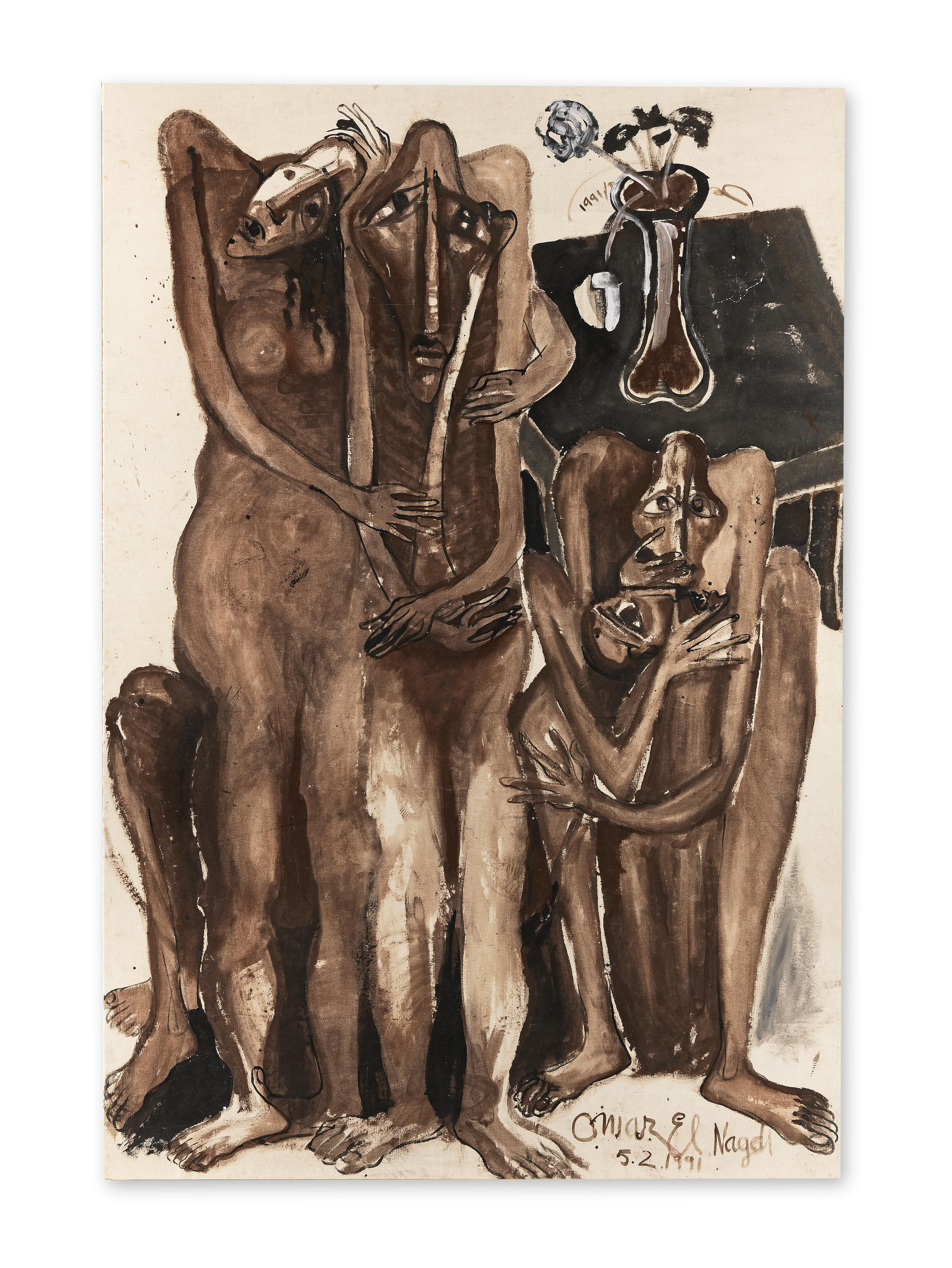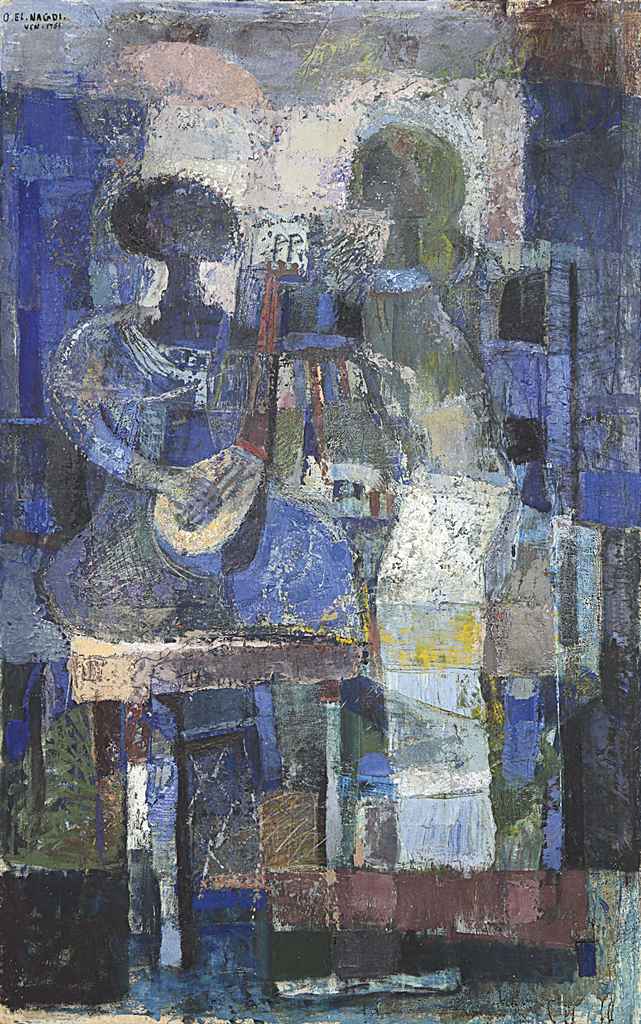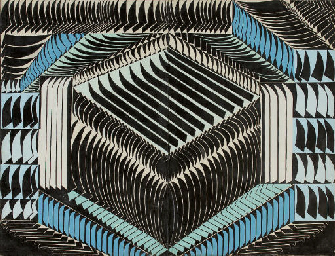Omar El-Nagdi (Egypt, 1931-2019)Gaza oil on canvas, four panels signed and dated, executed in 2009 250 x 900cm (98 7/16 x 354 5/16in).250 x 225 cm per panelFootnotesA MONUMENTAL NINE METRE QUADTYCH BY OMAR EL NAGDI DEPICTING THE 2009 GAZA WAR Provenance: Property from the Artist's Estate Exhibited: Arts-Mart Gallery, Omar El Nagdi: Fragments of a Luminary Cairo, February-March 2016 This monumental and highly significant painting captures the unimaginable hardship, fear and anguish of the Palestinian civilians during the Gaza War which was also better known in the Muslim world as the Gaza Massacre. This three-week armed conflict between The Israeli Defence Forces and the Gaza Strip Palestinian paramilitary groups began on the 27th of December 2008 and ended on the 18th of January 2009 with a unilateral ceasefire. The unrelenting attack on Gaza resulted in over a thousand Palestinian and thirteen Israeli deaths. Omar El-Nagdi found the persecution and the brutal assault on his Palestinian brothers and sisters deeply unsettling and distressing. The ongoing massacres by the Israelis, deeply affected the Egyptian artist and urged him to react to these monstrosities by impulsively expressing himself in this profound composition. Suffering has been an enduring theme in art for centuries, and the tradition of painting violence, pain and oppression has long been a source of expression for artists experiencing conflict. The artist communicates a deep and painful reality; this painting serves as a reminder and reflections of Palestinian history and the ongoing struggle. The historic moment of the 1948 Palestinian exodus also known as the Nakba in Arabic led to the displacement of hundreds of thousands of children and the ongoing war left many casualties. Towering and striking, the present work was painted two months after the conflict ended in 2009 and is one of the finest examples of the artist reacting almost concurrently to the world around him. A seminal piece of artistic activism, in the vein of some of the greatest recorded works in history like Picasso's "Guernica" and Goya's "Disasters of War". In his treatment of conflict, Nagdi clearly recalls Goya, whose set of 82 etchings were inspired by the scarring effect of the Franco-Spanish Peninsular War of 1807. Whilst divergent in form and composition, what Nagdi absorbs from Goya is the jarred, fragmented aesthetic that reflects the tumult of wartime discord. Goya was said to capture scenes in "agonised haste", and accordingly, the idea of the turbulence of conflict depicted with a ghoulish, monster like aesthetic is heavily incorporated in Nagdi's work. El-Nagdi transcribes literally the chaos of war, isolating each disproportioned figure onto the canvas yet bringing them all together through the agony expressed in their faces. Hopelessness, grief and despair are apparent in the body language of the men, women and children seen in this work. His figures, or rather creatures, appear inhuman and resemble fictional characters rather than people, showing how the sufferings and torturing of war has stripped them bare of their humanity and dignity. Each movement, each body part and each facial expression screams out from the canvas; the hands reaching out in despair and the frightened bulging eyes of the helpless victims. Omar El Nagdi was born in Cairo in 1931 and studied at the Faculty of Fine Arts of Helwan University. Nagdi continued his training in Russia and Italy, eventually graduating from the Academy of Venice in 1967. A prodigious pioneer in Egyptian art history, In the 1960s, Nagdi exhibited in Europe alongside the Western masters Claude Monet Pablo Picasso and Salvador Dali. His works were soon after acquired by leading institutions around the world. An active member of Cairo's art community and of the Liberal Artists' group headed by Taha Hussein, Nagdi was an extraordinary painter and who equally excelled as a film director and music composer. A multi-disciplinary artist,
Omar El-Nagdi (Egypt, 1931-2019)Gaza oil on canvas, four panels signed and dated, executed in 2009 250 x 900cm (98 7/16 x 354 5/16in).250 x 225 cm per panelFootnotesA MONUMENTAL NINE METRE QUADTYCH BY OMAR EL NAGDI DEPICTING THE 2009 GAZA WAR Provenance: Property from the Artist's Estate Exhibited: Arts-Mart Gallery, Omar El Nagdi: Fragments of a Luminary Cairo, February-March 2016 This monumental and highly significant painting captures the unimaginable hardship, fear and anguish of the Palestinian civilians during the Gaza War which was also better known in the Muslim world as the Gaza Massacre. This three-week armed conflict between The Israeli Defence Forces and the Gaza Strip Palestinian paramilitary groups began on the 27th of December 2008 and ended on the 18th of January 2009 with a unilateral ceasefire. The unrelenting attack on Gaza resulted in over a thousand Palestinian and thirteen Israeli deaths. Omar El-Nagdi found the persecution and the brutal assault on his Palestinian brothers and sisters deeply unsettling and distressing. The ongoing massacres by the Israelis, deeply affected the Egyptian artist and urged him to react to these monstrosities by impulsively expressing himself in this profound composition. Suffering has been an enduring theme in art for centuries, and the tradition of painting violence, pain and oppression has long been a source of expression for artists experiencing conflict. The artist communicates a deep and painful reality; this painting serves as a reminder and reflections of Palestinian history and the ongoing struggle. The historic moment of the 1948 Palestinian exodus also known as the Nakba in Arabic led to the displacement of hundreds of thousands of children and the ongoing war left many casualties. Towering and striking, the present work was painted two months after the conflict ended in 2009 and is one of the finest examples of the artist reacting almost concurrently to the world around him. A seminal piece of artistic activism, in the vein of some of the greatest recorded works in history like Picasso's "Guernica" and Goya's "Disasters of War". In his treatment of conflict, Nagdi clearly recalls Goya, whose set of 82 etchings were inspired by the scarring effect of the Franco-Spanish Peninsular War of 1807. Whilst divergent in form and composition, what Nagdi absorbs from Goya is the jarred, fragmented aesthetic that reflects the tumult of wartime discord. Goya was said to capture scenes in "agonised haste", and accordingly, the idea of the turbulence of conflict depicted with a ghoulish, monster like aesthetic is heavily incorporated in Nagdi's work. El-Nagdi transcribes literally the chaos of war, isolating each disproportioned figure onto the canvas yet bringing them all together through the agony expressed in their faces. Hopelessness, grief and despair are apparent in the body language of the men, women and children seen in this work. His figures, or rather creatures, appear inhuman and resemble fictional characters rather than people, showing how the sufferings and torturing of war has stripped them bare of their humanity and dignity. Each movement, each body part and each facial expression screams out from the canvas; the hands reaching out in despair and the frightened bulging eyes of the helpless victims. Omar El Nagdi was born in Cairo in 1931 and studied at the Faculty of Fine Arts of Helwan University. Nagdi continued his training in Russia and Italy, eventually graduating from the Academy of Venice in 1967. A prodigious pioneer in Egyptian art history, In the 1960s, Nagdi exhibited in Europe alongside the Western masters Claude Monet Pablo Picasso and Salvador Dali. His works were soon after acquired by leading institutions around the world. An active member of Cairo's art community and of the Liberal Artists' group headed by Taha Hussein, Nagdi was an extraordinary painter and who equally excelled as a film director and music composer. A multi-disciplinary artist,


.jpg)




.jpg)







Testen Sie LotSearch und seine Premium-Features 7 Tage - ohne Kosten!
Lassen Sie sich automatisch über neue Objekte in kommenden Auktionen benachrichtigen.
Suchauftrag anlegen